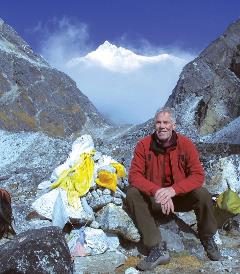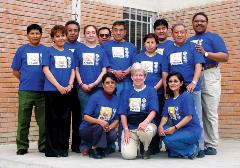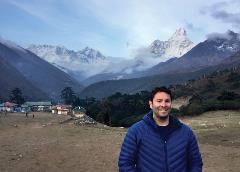Flying High
Three physiologists share their adventures studying science at high altitudes.
By Heather Boerner

Physiology is a science that is often conducted within the confines of a lab. But the discipline also takes some researchers to great heights—including above the Himalayas and to the Andes Mountains. Three physiologists tell us how they reached
physical and scientific heights.
The Animal Guy
As a kid, you could find William Milsom, PhD, tromping through the woods around whatever Army base his dad was stationed at, turning over logs and making pets of the salamanders, newts and turtles he found there.
Those would join a shed of parakeets and aquaria of tropical fish in the family menagerie. But it didn't occur to Milsom until college that this love of animals could become his career.
Milsom, professor emeritus and former head of zoology at the University of British Columbia in Vancouver, Canada, has been tromping around in the wilderness professionally ever since. He originally thought he'd focus on marine animals, but an expedition to Antarctica in the early 1970s changed all that.
"Studying penguins and giant petrels set everything off," he says. Since then, he's studied animal adaptations to extreme environments.
Today, Milsom is studying two different sets of resident high-altitude birds; one group has been at altitude only for thousands of years. The other, for millions of years.
But he's perhaps best known for his work with bar-headed geese, a unique breed. Bar-headed goose migration takes them from India's humid lowlands to Mongolian grasslands. In between, the birds climb 15,000 feet in the span of 12 hours—and then higher still—to surmount Himalayan passes.
"The question had always been, 'What can the birds do? And what do the birds do?'" Milsom says. Until the 2000s, scientists didn't have the technology to answer those questions. But then came the advent of 3D accelerometers, GPS tracking by satellite and logging devices. The geese's time had come.
Now they could ascertain whether the birds glided like albatross on trade winds or if they flapped their wings for the entirety of the 3,000-mile journey.
The verdict? "They're not albatross," Milsom quips. "They don't glide."
 In a series of papers published in Physiology, Science and elsewhere, Milsom and a team of researchers found that the birds flap their wings almost constantly, hugging the terrain of the Himalayas, and breathing faster to get enough oxygen from the thin
air. Then the team looked at how the geese moved that oxygen from the lungs to the blood, from the blood to muscle, and from muscle to cells and mitochondria.
In a series of papers published in Physiology, Science and elsewhere, Milsom and a team of researchers found that the birds flap their wings almost constantly, hugging the terrain of the Himalayas, and breathing faster to get enough oxygen from the thin
air. Then the team looked at how the geese moved that oxygen from the lungs to the blood, from the blood to muscle, and from muscle to cells and mitochondria.
In the process, Milsom has found himself in interesting environments—like running wild geese on a treadmill powered by a portable generator in "a tent in the middle of nowhere Mongolia." The idea was to test pulmonary function through exercise and to lower the oxygen level in the tent to see how they did. "You put them on this treadmill and turn it on. They'll start to walk," he says. "It just takes a little training."
Because the birds were suspected of carrying avian flu, the researchers wore personal protective equipment. "It would be so hot in there that you'd be sweating like mad," he says. "Your goggles would slowly fill up with perspiration. You'd have to continually drain them."
Milsom said his research is more than an academic question. In parts of the world, birds are already suffering from climate changes. Ascertaining how quickly and to what extent a bird might adapt as climate change drives them to seek cooler environments,
such as at altitude, he said, might help identify which species have the best chance of survival.
The Pregnancy Pioneer
Lorna Grindlay Moore, PhD, professor of obstetrics and gynecology at University of Colorado's School of Medicine, climbed to her first summit at age four. Moore was in her backyard in Rochester, Minnesota. She was going to hang from the very top of her swingset, and no one was going to stop her.
 As the family story goes, Moore scaled the rickety metal ladder that swung with each step. She reached the top, scooted over to the trapeze and locked her knees onto the metal piping.
As the family story goes, Moore scaled the rickety metal ladder that swung with each step. She reached the top, scooted over to the trapeze and locked her knees onto the metal piping.
As she flipped upside down, her hair streamed toward the earth and she hung, suspended by her knees, satisfyingly weightless.
When she was done, she fell to the ground, dusted herself off and said, "There. I can do anything."
That's the determination, Moore says, that keeps her pursuing the physiology of pregnancy in high places despite the occasional lack of grant funding and skepticism from some colleagues who don't see the value in studying pregnancy. As a result, Moore has pioneered research into not just pregnancy at altitude but also how humans evolved to have healthy babies in extreme conditions. That research may now help lowlanders have healthy pregnancies, too.
Originally trained as an biological anthropologist, Moore wanted to study not just the evidence of evolution in the fossil record but primarily the process of evolution itself. That led her to pregnancy. "And that," she says, "took me to high altitude."
When her second child was a baby, Moore traveled to Peru with her children and husband in tow. She had already ascertained that women with higher blood oxygen levels during pregnancy at high altitudes had normal-weight babies, something that is unusual at altitude since most people's blood oxygen drops as they ascend.
In later studies in Tibet and then Bolivia, she determined that when lowland women became pregnant at altitude, their placental blood flow didn't increase as much as it would have had they been on their home soil. Native highlanders, meanwhile, have the kind of blood flow of women at much lower altitude. (This is important because fetuses already exist in a low-oxygen environment during gestation, and at altitude that oxygen can be decreased.) Those native highlanders, it turned out, had genetic adaptations that enabled them to deliver normal levels of oxygen to the placenta while pregnant at altitude.
As a result, the highlanders—whether from Tibet or the Andes—gave birth to babies who weighed more than the babies born to lowland women residing at high altitude.
The difference in birth weights between lowland women and highland women were so consistent and pronounced across income levels and elevations from 7,000 feet to 16,000 feet that they "practically knocked your socks off," Moore says.
In Bolivia, her research identified among highlander women a mutation to AMPK, a metabolic signaling enzyme. It was an alteration associated with preservation of normal infant birth weight and uterine blood flow during pregnancy at altitude.
Now Moore is studying whether that discovery might help identify novel targets for drug therapies for women without genetic adaptations. The goal is to see if they might help women whose placental blood flow is compromised by pregnancy complications of fetal growth restriction or preeclampsia. So far, what she's learned is that AMPK operates in ways she couldn't have imagined.
"It looks as though AMPK has quite different effects on the maternal versus the fetal side of the placenta," she says. And she doesn't yet know why. But she's going to keep looking because, to Moore, high altitudes are a great natural laboratory for studying pregnancy and other hypoxic complications.
"It's now well-documented
that the maternal responses to pregnancy and the fetus' intrauterine development not only affect maternal and newborn mortality but are also among the strongest determinants of susceptibility to cardiovascular and other diseases during adult life,"
Moore says. "High altitudes therefore constitute a natural environment for understanding fundamental questions of life itself."
The Accidental Physiologist
As a teenager, Trevor Day, PhD, was more interested in working as a lifeguard at sea level than investigating complicated biological interactions in thin air. He says now that if his teenage self had known how creative biology could be, he might have done better in high school biology.
 But even back
then, the physiology of breathing was "already in the air for me." Managing breathing was key to being a good swimmer. And when he graduated high school and trained to be an emergency medical technician, there was breathing again. He learned after
watching one too many asthma attacks that "if you don't have an airway, you've got nothing."
But even back
then, the physiology of breathing was "already in the air for me." Managing breathing was key to being a good swimmer. And when he graduated high school and trained to be an emergency medical technician, there was breathing again. He learned after
watching one too many asthma attacks that "if you don't have an airway, you've got nothing."
"Respiratory and cardiovascular physiology were some of the most important things in terms of intervening in crisis," says Day, professor of physiology at Mount Royal University in Canada. Now he realizes, "I was dabbling in applied physiology early on."
It was Day's curiosity that landed him in an undergraduate environmental physiology course years later. That's where he was introduced to mountain physiology and where he read the book "Into Thin Air" about a 1996 disaster on Mount Everest.
"[Mountain physiology] kind of had everything: an environmental stressor, respiratory physiology, plus adventure," he says. "We read the book, and I never dreamed that 15 years later, I'd be looking at Everest with my own eyes on a trek to base camp in 2012."
Since then, he's returned to the mountain multiple times, studying the stressor of thin air on human systems. His work started in respiration. But quickly, it became clear that to study the effect of low oxygen on humans, he had to look beyond the dispersal of oxygen. Sure, everyone increases their breathing as they climb the mountain, he says. But it's more than that.
"Every organ system has to respond in some way to compensate for low oxygen," he says. "As one organ system compensates, another organ system has to compensate for that compensation. They're all talking to each other."
Take, for instance, kidney function in native lowlanders. As soon as you breathe more to replace that missing oxygen, your pH levels shift. Day and his team came up with an index of renal activity during ascent to high altitude.
But Day may be best known for a single case report, published in the Journal of Applied Physiology in 2018, which added to what Moore had already learned about pregnancy in high places. And it came entirely by accident.
"As we were ascending in the Everest region, our lead guide was telling us about his wife, who was pregnant," Day says. "I asked if we were going to meet her, and he said, 'Yeah, I think she's going to come along.'"
"OK, what?!" Day said at the time. "She's seven months pregnant!"
But she climbed. And the case report received write-ups in the New York Times and elsewhere. To Day, it wasn't proof that all women could exercise more during pregnancy. It was proof of the wonders of what some humans could do.
"It's a nice reminder that so much of science is just getting into the lab or in the field and doing the work and then weird stuff happens," he says. "If you're paying attention, you might learn something new. So much of science is serendipity!"
Today, Day has his eyes on the stratosphere. He's submitted a grant to the Canadian Space Agency to study physiology on the International Space Station, with an eye to the upcoming high-orbit lunar gateway platform.
"Our exploration of space is coming back again," he says. "We can be excited about the moon again."
The Physiologist Magazine
Read the Latest Issue
Don’t miss out on the latest topics in science and research.
Contact Us
For questions, comments or to share your story ideas, email us or call 301.634.7314.


